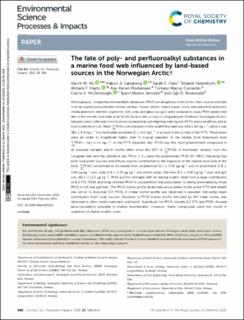| dc.contributor.author | Aasim, Ali M | |
| dc.contributor.author | Langberg, Håkon Austad | |
| dc.contributor.author | Hale, Sarah | |
| dc.contributor.author | Kallenborn, Roland | |
| dc.contributor.author | Mortensen, Åse-Karen | |
| dc.contributor.author | Hartz, William F | |
| dc.contributor.author | Ciesielski, Tomasz Maciej | |
| dc.contributor.author | McDonought, Carrie A. | |
| dc.contributor.author | Jenssen, Bjørn Munro | |
| dc.contributor.author | Breedveld, Gijs D. | |
| dc.date.accessioned | 2021-11-04T10:47:02Z | |
| dc.date.available | 2021-11-04T10:47:02Z | |
| dc.date.created | 2021-03-12T19:30:14Z | |
| dc.date.issued | 2021 | |
| dc.identifier.citation | Environmental Science: Processes & Impacts. 2021, 23 588-?. | en_US |
| dc.identifier.issn | 2050-7887 | |
| dc.identifier.uri | https://hdl.handle.net/11250/2827820 | |
| dc.description.abstract | Although poly- and perfluorinated alkyl substances (PFAS) are ubiquitous in the Arctic, their sources and fate in Arctic marine environments remain unclear. Herein, abiotic media (water, snow, and sediment) and biotic media (plankton, benthic organisms, fish, crab, and glaucous gull) were sampled to study PFAS uptake and fate in the marine food web of an Arctic Fjord in the vicinity of Longyearbyen (Svalbard, Norwegian Arctic). Samples were collected from locations impacted by a firefighting training site (FFTS) and a landfill as well as from a reference site. | en_US |
| dc.language.iso | eng | en_US |
| dc.title | The fate of poly- and perfluoroalkyl substances in a marine food web influenced by land-based sources in the Norwegian Arctic | en_US |
| dc.type | Peer reviewed | en_US |
| dc.type | Journal article | en_US |
| dc.description.version | publishedVersion | en_US |
| dc.source.pagenumber | 588-? | en_US |
| dc.source.volume | 23 | en_US |
| dc.source.journal | Environmental Science: Processes & Impacts | en_US |
| dc.identifier.doi | 10.1039/d0em00510j | |
| dc.identifier.cristin | 1897770 | |
| cristin.ispublished | true | |
| cristin.fulltext | original | |
| cristin.qualitycode | 1 | |
